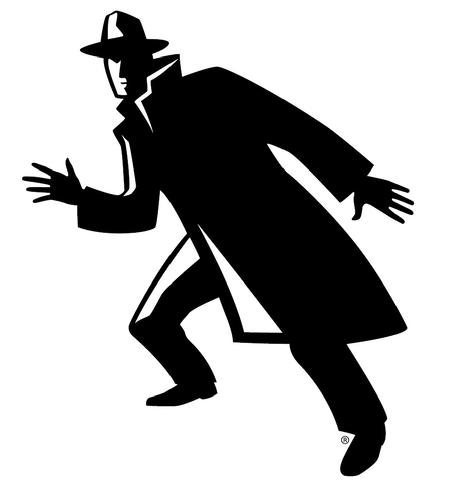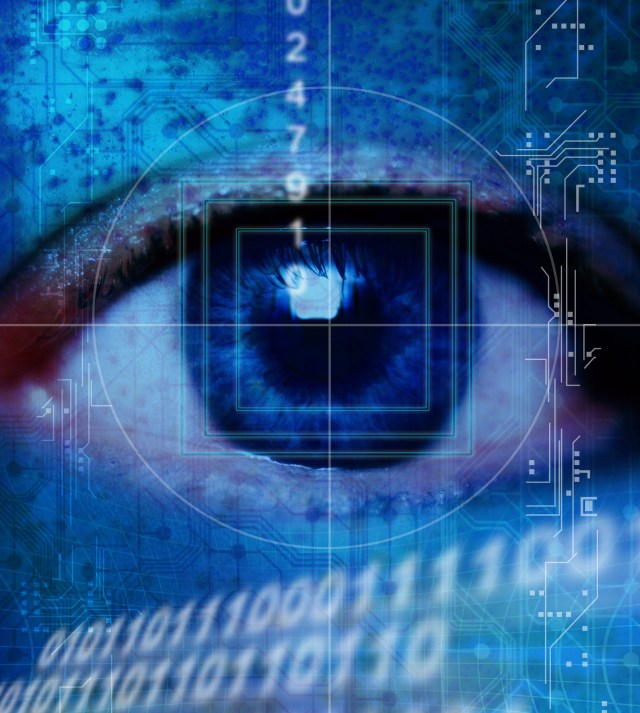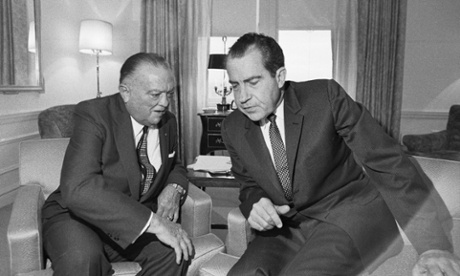In the 20th Century, 57 major wars were fought in the world (historyguy.com). All of these were “hot” wars, but in the 20th Century, a new kind of war developed. Another Orwellian term, the “Cold War” (Orwell, A Bomb) was fought in the shadows by trench-coated operatives using modern technical gadgetry to learn secret information about the opponent, and to undermine the opponent’s efforts to do likewise to us. Such was the fable built around the new, strong, very silent type “secret agent man”. Of course, undercover detection had been around at least since Octavius Caesar. It is the “technical gadgetry” that sets off 20th and 21st Century surveillance arts from all previous epochs.

Fingerprinting; from Forward Looking to Backward Looking Surveillance
A paper published in 1892 by Englishman Sir Francis Galton described a way to group and classify fingerprint patterns. His idea was developed by Sir Edward Henry, Inspector General of the Bengal Police, in to the searchable format we have today (Mayhew), and surveillance was transformed. The definitive nature of finger prints dated to China in the Third Century BCE, a thumb print used to identify pottery makers, and later, legal documents (Bonanza, onin.com). In 1892 the first crime was solved in the West using finger prints. By 2010, the Department of Homeland Security had prints of 100 million people, many just the forefinger and thumb. The largest repository of ten-digit Automated Fingerprint Identification System belongs to the FBI, containing prints for over 55 million people (PoliceOne.com).
Prior to the discovery of fingerprints, surveillance and investigation required “forward looking” tactics, methods used in real time: stake outs, shadowing, telegraph intercepts, spying, and so on aimed at catching the culprit in the act.
Fingerprinting, and an avalanche of forensic and other tools to come, would for the first time allow “backward looking surveillance” (Desai, 4). You no longer needed to personally witness someone enter through a window, open a bedroom door and stab someone, leaving the blood-stained knife on the floor. Fingerprints on the widow sill, bedroom doorknob and bloody knife handle would tell the tale, now. True, earlier investigations had followed blood leads and foot tracks to help with crime reconstruction and to find suspects. But fingerprinting, DNA and other forensics allowed pinpoint identities to be made from very small amounts of trace evidence.
Is It a Crime, Yet?
Often, the real difference between forward looking and backward looking is whether or not the crime has yet been committed. The forward looking strategies are “anticipatory rather than postliminary” (Joh, 46), so, while legally and logistically harder and often more risky to deploy, are aimed at heading off illegal acts, such as terrorism, drug sales, assassinations, etc, before they can be committed. Remember, “preventive policing” was the calling of the French Sûreté, with its strong use of undercover operatives and informants, and since 9/11, this calling has been the prime directive of Homeland Security.

Political science warns that a police state is created when you transform a crime-detecting police force into a crime-preventing policing apparatus (Fiedor). The War on Drugs declared by President Richard Nixon in 1971 was a sweeping initiative in crime prevention that laid groundwork to start building the surveillance state, set well on its way to completion by the USA PATRIOT Act of 2001 (Bloss).
The Post-911 Frenzy and Homeland Security
Six weeks after the September 11, 2001 attacks brought down the World Trade Center, a law was passed almost unanimously that drew the American congress together as nothing has been able to do since. The “Uniting and Strengthening America by Providing Appropriate Tools Required to Intercept and Obstruct Terrorism Act” (USA PATRIOT Act) consisted of 150 sections amending 15 federal statutes which, among other things made it easier for law enforcement agencies to get search warrants for business, medical, educational, library, and bookstore records without showing probable cause (Kranich).
Under the newly formed Homeland Security Agency, a level of law enforcement information sharing and coordination has been achieved that the Sûreté would surely covet.
As pointed out by Laqueur and others, widespread panic after a large terrorist attack can have socially disturbing consequences, and some argue this is one of them. For a law of such magnitude, offering such broad, new surveillance powers, to pass in such short order might be explained in three words: the terrorists won.
Then there is the “conspiracy buzz”: The attack on 9/11, like the Reichstag bombing in Germany or the Pearl Harbor attack was made or allowed to happen so the unsavory elements of power could use the chaotic aftermath to get what they wanted (Whatreallyhappened.com, Griffin).
This level of speculation will find no home on this site, but a cautionary lesson can be legitimately taken when we recall the governments in history that have been ruthless in getting and holding power; Rome, Berlin, Beijing, Moscow and even DC. Whatever level of surveillance a government can use, history has shown it will use.
But, should it be troubling? The announced goal of all this surveillance, after all, is to make us safer from terrorism. Right?
Interesting aside:
Government Surveillance/Snowden Interview, Last Week Tonight with John Oliver:
As Edward Snowden was enabled to reveal through a network of sometimes reluctant truth tellers, the capabilities of the National Security Agency (NSA) to store and analyze a world full of emails, phone calls, Internet resources, bank records, library records, school records, business records and more are astonishing (The Guardian).
Government protection: We’ve been here before
Online behavior of young people transmits immense raw data to government and private corporations that would have made their grandparents very uncomfortable to see in an FBI dossier.

Many of those grandparents still remember COINTELPRO (Counterintelligence Program) begun in 1956, an outgrowth of the Red Scare used and expanded by J. Edgar Hoover’s FBI. Hoover was the first director of the bureau, and if Pinkerton was America’s Vidocq, Hoover was its Napoleon. He considered himself untouchable by normal law, and employed secret methods, including illegal wiretaps, to keep abreast of things. Legislators would not often question his methods for fear they would get on his watch list (Barnes, Winship).

Original caption: 11/14/1968-New York: FBI Director J. Edgar Hoover (left) confers with Richard M. Nixon, the President-elect, at the latter’s “transition” headquarters at the Hotel Pierre here Nov. 14th. Hoover, 73, said he would be willing to serve under Nixon, after an hour-long meeting during which they discussed “internal security matters.” — Image by © Bettmann/CORBIS
Hoover was a rabid anti-Communist, and took it upon himself to rid America of Communism. Named to head background checks of people being investigated by the House Un-American Activities Committee (HUAC), Hoover’s FBI used questionable investigative methods, often using secret informants, to take the jobs of thousands of government workers. Under rather nuanced orders from Richard Nixon, first as a Senator co-chairing HUAC with Joe McCarthy, then later as President, the FBI infiltrated “commie” civil rights, peace, women’s, and other progressive and militant groups in the 1950’s and in to the ‘70’s (Barnes, Winship).
Nixon’s domestic surveillance was so extreme that the Final Church Investigation report revealed:
• Over 26,000 individuals were at one point cataloged on an FBI list of persons to be rounded up in the event of a “national emergency”
• Over 500,000 domestic intelligence files were kept at the FBI headquarters, of which 65,000 were opened in 1972 alone
• At least 130,000 first class letters were opened and photographed by the FBI from 1940 to 1966
• A quarter of a million first class letters were opened and photographed by the CIA from 1953 to 1973
• Millions of private telegrams sent from, to, or through the United States were obtained by the National Security Agency (NSA), under a secret arrangement with U.S. telegraph companies, from 1947 to 1975
• Over 100,000 Americans have been indexed in U.S. Army intelligence files.[30]
• About 300,000 individuals were indexed in a CIA computer system during the course of Operation CHAOS
• Intelligence files on more than 11,000 individuals and groups were created by the Internal Revenue Service (IRS), with tax investigations “done on the basis of political rather than tax criteria”
Way back in a 1975 appearance on Meet the Press, Sen. Frank Church (D-ID), chairman of the United States Senate Select Committee to Study Governmental Operations with Respect to Intelligence Activities warned:
In the need to develop a capacity to know what potential enemies are doing, the United States government has perfected a technology capability that enables us to monitor the messages that go through the air . . . Now that is necessary and important to the United States as we look abroad at enemies or potential enemies. We must know at the same time that capability at any time could be turned around on the American people. And no American would have any privacy left, such is the capability to monitor anything, telephone conversations, telegrams, it doesn’t matter. There would be no place to hide.
This warning was issued, remember, almost 50 years ahead of revelations by Edward Snowden detailing intelligence capacity capable of drawing a bead on any individual that fits the algorithm derived profile. Social Network Analysis has opened “Windows” on the personal lives of millions of people in America, hundreds of millions in the world. This one aspect of the Internet has greatly undermined the “expectation of privacy” that holds the surveillance community relatively at bay (McAninch, 1991; Bloss, 1996).
According to Regan,
With the recent exposure of the NSA’s PRISM program by whistleblower Edward Snowden, many people—especially activists—are wondering: How much privacy do we actually have? Well, as far as electronic privacy, the short answer is: None. None at all. There are a few ways to protect yourself, but ultimately, nothing in electronic communications is absolutely protected.” (Monthly Review)
The issue has been made in to a question of “privacy vs. anonymity” (Wang). In this logic, privacy is what we have at home, away from the outside world. It is our sanctum, with all constitutional protections.
Anonymity is what we have out in the world, with people, but unknown to them, at a club or beach or demonstration. There are all kinds of communications online that are anonymous, but harmless, and often necessary to forming opinions. As warned by Desai, “(O)ur current understanding of associational freedom is thin. We over-focus on speech and miss the importance of the precursors to speech — the ability to share, explore, accept, and reject ideas and then choose whether to speak” (Paper Abstract).

- Photo by Jaren Wilkey/BYU Copyright BYU PHOTO 2004 All Rights Reserved photo@byu.edu (801)422-7322
Not everyone who wants anonymity is a child molester or terrorist. Activists often want to work together online to create a better world, but, no matter how legal and constitutionally protected are their efforts, few want their name and other identifying information made public outside their control.
Bills like the one recently introduced by Senator Diane Feinstein, requiring social media companies to report “terrorist activity” are ludicrous when they can define terrorist activity as trying to maintain online anonymity. Planning a political event or protest, researching “Jihad” for a school paper, or blowing the whistle on a company all currently allow anonymity. Do we want to make any of that information public? (Wang)
Corporate Data Mining
Not all the threats are posed directly by governments. Corporations trade and sell data and mine it to build customer profiles that allow individualized advertising. You say you went on whatever.com and had your eye on a nice Widget Classic, and suddenly, Widget Classic ads started showing up in your browser (a version of personal experience)? While this can be annoying, it can be seen as the price paid for allowing the Internet to be used for commercial purposes, which was one motivator for its development.
The main problem is that all that data is subject to government subpoena, and government has a law enforcement component not held by corporations, and enough data already stored to prove the “six degrees of separation” (Whatis.com), that everyone eventually connects if you follow it back enough. Some are starting to suspect how inadequate would be the efforts of a Sorcerer’s Apprentice to stop the watery surge of information, and the unintended consequences of all that data sloshing around the cyber world.
This, of course, is the rub. Surveillance technologies are growing so that all information is becoming data that can be used to track and profile. Where that data leads and what it is used for is the overriding question. Information gathering practices have and can be turned toward the governed in very unpleasant ways. Tales of Stalin’s secret police whisking dissidents off to Siberian Gulags, or worse, filled Red Scare nightmares, and likely presaged George Orwell’s vision, now an adjective: Orwellian.
Even though the US or any other country may be trusted not to use oppressive elements of these surveillance programs against its people, software developers can sell their devices to anyone, so the technologies of surveillance can end up in less trustworthy hands. With the pervasiveness of the technology, especially in the wake of 9/11, we are learning that this weapon, like any, can be used for us or against us, depending on who is holding it.
Everybody’s a Spy
In 2001, Sanyo introduced the first camera incorporated in to a cell phone, and it was off to the races. Since then, “selfie” has become a word, and improved miniature camera technology has enabled unprecedented surveillance capability. It is rare today to turn on a news program anywhere in the “25-hour” news cycle without at least one story featuring footage or photos from a security camera, dash cam, traffic cam, nanny cam, body cam, satellite, drone or cell phone. Add sharing with Facebook, Instagram, Twitter and a dozen other apps (Gizmodo), and everyone can be a spy or news reporter.
Early the morning of January 1, 2009, a train load of Bay Area Rapid Transit (BART) New Year’s Eve riders was stopped at the Fruitvale station in Oakland. They were prevented from debarking while BART police struggled with a handcuffed young black man face down on the platform. One of the officers bent over the youth, Johannes Mehserle, suddenly drew his gun and fired in to the back of Oscar Grant III, killing him (McLaughlin, et al).
That night, a number of passengers made cell phone or camera recordings and some were shown on all the news programs. The Internet took them viral, and now it looked like, if Big Brother was watching, we were looking back.
That shooting was the beginning of a trend that is making police all over America have to rethink engagement practices. As the story unfolded of the 2014 shooting in Ferguson, Missouri, of a young, black man by a white police officer, a number of videos went public which, in large part, confirmed a growing impression of racist police with no accountability in taking the lives of black men. In a one-year period ending in May, 2015, thirteen police involved shootings were recorded by surveillance cameras or cell phones and made public. Most of the victims were black, young, male, and/or unarmed (Vicens).
The power of the Internet, while undermining funding for big print and television news agencies, has spawned an army of “citizen journalists,” whose web logs now carry news and analysis, of varying skill and veracity, capable of reaching millions of people around the world. This democratization of news gathering and distribution is evolving and being watched closely by arbiters of publicly received knowledge. “Mainstream” news agencies are challenged for cutting back on investigative journalism and sometimes promoting a propagandistic tone, as with the fear mongering about “weapons of mass destruction” in the lead up to the Iraq invasion (World Socialist Web Site).
The Huffington Post has declared we have already created a security state that
. . . is all-knowing, all-seeing and all-powerful. It operates beyond the reach of the president, Congress and the courts, and it marches in lockstep with the corporate elite who really call the shots in Washington, DC. Beware of what you say, what you read, what you write, where you go, and with whom you communicate, because it will all be recorded, stored and used against you eventually, at a time and place of the government’s choosing (Whitehead).
Has it happened? Is it now necessary to cultivate that “habit that became instinct — in the assumption that every sound you made was overheard, and, except in darkness, every movement scrutinized” (Orwell)?
At the very least, the constant, highly publicized look-out for terrorist plots has negative effects, as community trust, especially among different ethnicities, falls (Bloss).
While many white Americans who are not engaged in any illegal or nefarious activity may have less to worry about, international visitors are especially scrutinized in accordance with the United States Visitor and Immigration Status Indicator Technology (US-VISIT) program, which uses all the tools at hand—biometric, cyber, and more–to track foreign visitors (Bloss, 220).
With most US surveillance aimed, for now, outside the United States, chances rise for foreigners getting ensnared in a National Security Agency probe of uncle Hassan or cousin Enrique. The ongoing and open ended nature of these investigations is a concern to Joh, who warns, “While traditional covert investigations involve targeted policing based upon intelligence, covert policing has expanded to include more diffuse and open-ended investigations premised on probabilities and temptations, and thus without specific suspicions, complaints, or suspects.”
Desai also warns that all the data from all the investigations is accumulated and horded in to a larger and larger database that can be continually combed through (583).
Another concern of the surveillance state hits closer to home for many. That is its use by local police to force low level drug users, mostly college students, to become police Confidential Informants, often wired for sound, to help bring down dealers. 60 Minutes reported how police used coercive tactics, threats of long jail terms (even for first time pot offenders) and the end to their academic and career ambitions unless those arrested for even minor drug use agreed to go undercover and do sometimes dangerous work, often more than once (Stahl). Such aspects of the surveillance state are more worrisome to parents in Middle America, as methamphetamine use shoots up and police fight a more aggressive war against the growing popularity of pot. Not the more grandiose Big Brother is Lurking scenarios usually conjured by this conversation, it is none the less important to this examination.
Closing Thoughts on a Big Brother World
Starting in 1962, scientists and academics were seeking ways to speed up and reduce the size of computers and find ways to allow them to share and analyze data among them. By 1995, the Internet was fully commercialized in the United States; the cyber universe had sprung from the head of MIT, among many others (Computer History Museum).
Now over twenty years after the Internet first toddled out, we, particularly those born after the end of the 20th Century, take for granted that we can now hold in the palm of our hand the powers of analysis and communication once held only by universities, militaries, banks, television networks and record companies. Installing wiretaps require the highest burden of legal proof, but a great deal of what goes on in Cyber Universe is another matter.
A proactive law enforcement, whose aim is to jump in front of crime before it occurs, demands a massive surveillance apparatus. Stopping crime before it happens calls to mind uncomfortable images of a “Thought Police”. That term back in 1948 conjured images of the Gestapo and KGB, concentration camps and gulags. Today’s plugged in generation has never known a divided Germany or the oppression of missile silos and fallout shelters. They have been raised with the power of the world in their hand, and the power of it has been felt from Cairo to beyond. I’m willing to believe they know something I don’t. Maybe that ability of those being watched to spy back does leave some sense of a level playing field and increased security for everybody.
One thing that has shown clearly in this 2100 year journey through surveillance history is the importance of personal integrity in anyone’s desire to uphold the law. It seems self-evident, now. But when Henry Fielding refused to be bribed, satirized the practice in his writings, he called out a shout for integrity that has echoed down through the Bow Street Runners, Thames Police, Bobbies, Pinks, Feds and local policing. If we expect public honesty and respect for law, it must be practiced personally by those who uphold it. This has not, unfortunately, always been the case. With power comes responsibility. It is hard for someone with power to stay honest when no one is watching, and so body cams on police and nanny cams are becoming pervasive.
Another lesson is the wonderful lesson that people can push back, and have done so through history.
Finally, people seem to say, stay out of our personal affairs, but heavy surveillance in common spaces is OK. Recent bay area news reports that not all surveillance cameras aboard BART trains actually recorded anything, but were there as a deterrent, were not well met by the public after a fatal shooting aboard a car with a fake camera at the beginning of 2016 (McGall, et al). BART has since said they will get all the cameras working.
It is perhaps appropriate to end out this rumination with the final words from President Barack Obama’s 2016 State of the Union address:
“Our memory is long, and our reach has no limits.”

Pingback: Keep police honest–Look back! | Big Brother is Watching, but, Who Cares?